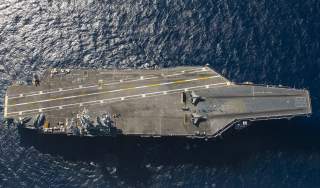India's Aircraft Carrier Future: British Designed and F-35 Armed?
Here is where this all could go.
India’s search for a third carrier recently made big news in the United Kingdom when it was announced that Indian Navy officials visited the Rosyth dockyard in Scotland, where the Royal Navy’s HMS Queen Elizabeth carrier was built. Reports have suggested that this delegation was interested in buying plans for the QE as a basis for their third carrier, the INS Vishal.
But why is India interested in a British design? What planes might it use? Could it lead to an F-35 purchase by India?
India’s prior experience with the INS Viraat, a former Royal Navy aircraft carrier could have lead to their preference for British design. The INS Viraat was decommissioned in 2017 after serving the Indian Navy for over thirty years. It was replaced by the INS Vikramaditya, a former Russian carrier, but the INS Vikramaditya has had significant issues with its powerplant and boilers. The INS Vikramaditya’s issues have proven deadly, with a boiler fire killing an officer on board in April 2019.
While the INS Viraat also killed one of its officers in a similar fire in 2016, the INS Viraat is far older than the INS Vikramaditya and served for far longer. The INS Vikramaditya has killed three people in the five years she has been in service.
This abysmal safety record probably has driven interest in British designs, which are known to be generally safer and feature modern gas turbines in contrast to the INS Viraat and INS Vikramaditya’s boilers.
With regard to planes, both the INS Vikramaditya and the INS Vikrant (India’s second carrier, currently undergoing trials) are designed to use MiG-29Ks, navalized variants of the MiG-29. However, problems with these aircraft may lead to the procurement of a new carrier-borne aircraft in the near future.
The INS Vikramaditya, INS Vikrant, and the HMS Queen Elizabeth are “ski-jump” carriers which utilize a ramp at the end of the runway to loft aircraft into flight. Conversely, most modern Western naval fighters such as the F/A-18 Hornet and Super Hornet, Rafale M, and F-35C are designed to use a catapult to be launched from the flight deck, which allows them to carry more upon takeoff.
While Dassault says that the Rafale M could easily be adapted to fly from ski-jump carriers, India is said to be considering installing a catapult on the INS Vishal. Designs were made to fit the second carrier in the Queen Elizabeth-class, the HMS Prince of Wales, with a catapult, but were eventually scrapped to reduce cost and maintain compatibility with the HMS Queen Elizabeth.
What India will select as a naval fighter comes down to a balance of cost, capability, and whether they plan to install a catapult on their third carrier. They could stick with the MiG-29 for all three carriers, the least capable, but cheapest option. They could adopt the Rafale M, which would be mid-priced and potentially suitable for all three carriers in all configurations if both catapult and ski-jump variants were adopted. Or they could attempt to buy the F-35B, which is known to operate off the Queen Elizabeth’s ski-jump.
India buying the F-35 could be potentially politically toxic due to America’s relationship with Pakistan. However, after India’s withdrawal from co-developing the Su-57 jet with Russia, there have been rumbles of F-35 interest within the Indian Air Force. Classified briefings were said to have taken place early in 2018, and Lockheed’s pitch of the “F-21” jet to India was accompanied by the tagline “India’s pathway to F-35”, though this was quickly redacted.
However, as the Rafale seems to be the favorite to win India’s “MMRCA 2.0” contract, a possible purchase of the Rafale M seems the most likely if the Indian Navy decides to upgrade their fighter aircraft.
Charlie Gao studied Political and Computer Science at Grinnell College and is a frequent commentator on defense and national security issues.
Image: Flickr.

